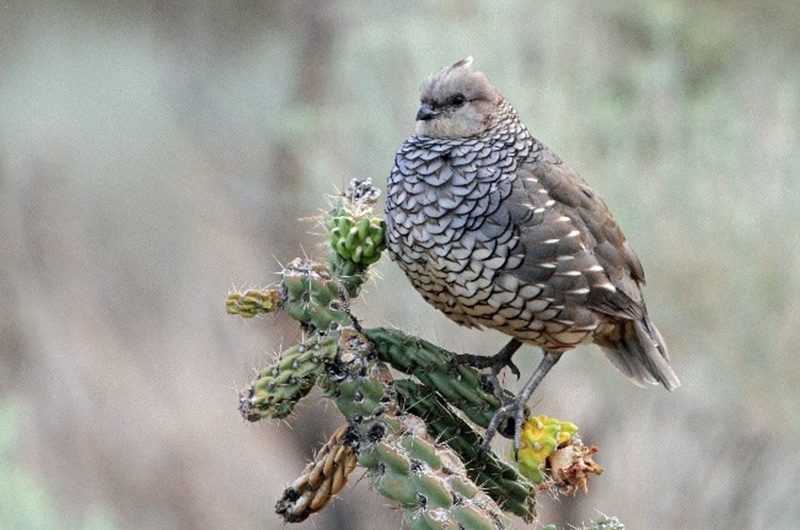LandPKS Learning
Habitat Hub

Scaled Quail
Scaled quail populations can fluctuate each year in response to weather in a boom-bust cycle, mainly from a lack of rain or heavy snowfall. These weather events reduce food supplies and cause mortality, but quail population can rebound in years with ample food. They typically have short life spans but high reproductive potential.
Callipepla squamata
Identification
The scaled quail is a compact gamebird with short, rounded wings and is about 12 in/30 cm in length. It has a distinct buffy to white crest on its head. Males and females look similar with an intricate pattern of dark brown “scales” on their breasts and bellies and overall bluish-gray coloring on their breasts and backs.
Observation Tips
Scaled quail are often seen on the ground feeding or running from danger; if they flush, they do not usually fly far. They travel in groups called coveys from fall through the spring and sleep in a circle facing outward. Beginning in spring, males will perch on a fence post, tree, or shrub and give a shriek (“whock!”) to attract females. Scaled quail can be seen year-round in the desert grasslands and shrublands of southwestern U.S. and northern Mexico.
Interesting Fact
Scaled quail populations can fluctuate each year in response to weather in a boom-bust cycle, mainly from a lack of rain or heavy snowfall. These weather events reduce food supplies and cause mortality, but quail population can rebound in years with ample food. They typically have short life spans but high reproductive potential.
Ideal Habitat
Scaled quail are found in desert grasslands and shrublands throughout the year. There is considerable variation in vegetation composition and cover throughout their range, but appropriate habitat for scaled quail must include nesting and loafing (or resting) cover (30-50% herbaceous cover) and food (mostly seeds and insects) with enough bare ground for traveling by foot. Preferred habitat includes a diversity of native grasses, abundant forbs, and scattered shrubs (approximately 5-20% shrub cover), such as sand sagebrush, yucca, cholla, wild plum, pinyon pine-juniper, skunkbush sumac, fourwing saltbush, and honey mesquite. Although scaled quail will avoid shortgrass areas with no shrub cover, they will also avoid areas with dense shrub cover (>20%). They may use crop fields, and edges adjacent to native rangeland for nesting provided there is sufficient cover. They nest on the ground, often under a low-growing shrub or concealed by other vegetation, and they will occasionally nest under old farming equipment and other sources of man-made cover.

Range map provided by BirdLife International
Management Activities that Benefit Species – Best Management Practices (BMPs)
Light to moderate grazing with approximately 30-40% utilization of forage species should promote mid- and late-seral plant conditions and plant diversity. These conditions provide the necessary food and cover requirements for scaled quail. Soil aeration treatments, shallow strip disking, and mechanical brush control may also benefit scaled quail through soil disturbance and forb growth, provided adequate shrub cover remains intact. Brush piles near natural or man-made water sources can provide cover for scaled quail. Plant native vegetation buffers around crop fields to increase habitat suitability in agricultural landscapes. Prescribed fire may reduce encroaching trees and promote forb growth, provided adequate shrub cover remains intact.
Management Activities to Avoid
Avoid heavy grazing, particularly during drought, which reduces residual grass cover and available nest sites for scaled quail. Avoid brush removal to <5% shrub cover, which reduces nesting and loafing cover for scaled quail.
Other Species that Benefit from Similar Habitat Management
Other species that may benefit from habitat management for scaled quail include Cassin’s sparrows, lark buntings, and northern bobwhite quail.
Download
Download the Scaled Quail factsheet
Other Resources
BirdLife International and Handbook of the Birds of the World. 2019. Bird species distribution maps of the world. Version 2019.1. Scaled Quail
The Cornell Lab of Ornithology, Birds of the World Scaled Quail
The Cornell Lab of Ornithology. All About Birds Scaled Quail
Orange et al. 2017. Oklahoma State University Extension. Scaled Quail Ecology and Management in Oklahoma. NREM-9019.
Photo credit: Greg Schechter/Flickr
Mobile App | Data Portal | Knowledge Hub | Habitat Hub | Learning Collections | Blog | About | Contact | Support



